- Last Updated: December 16th, 2025
Key Takeaways
PCBs are toxic chemicals that can linger in the environment and contaminate drinking water, posing serious health risks such as cancer and immune system damage.
Industrial activities, improper waste disposal, and old equipment containing PCBs contribute to the contamination of water sources; therefore, prevention requires proper maintenance, adherence to strict regulations, and public education.
Individuals affected by PCB contamination can seek legal action for compensation and remediation efforts with the help of specialized attorneys like those from Trulaw.
Overview of PCB Contamination in Drinking Water
Question: How do you address PCB contamination in drinking water?
Answer: The primary method to address PCB contamination in drinking water is through the use of granular activated carbon filtration.
On this page, we’ll discuss this question in further depth, an overview of what PCB contamination is, associated risks and complications linked to PCB contamination, and much more.
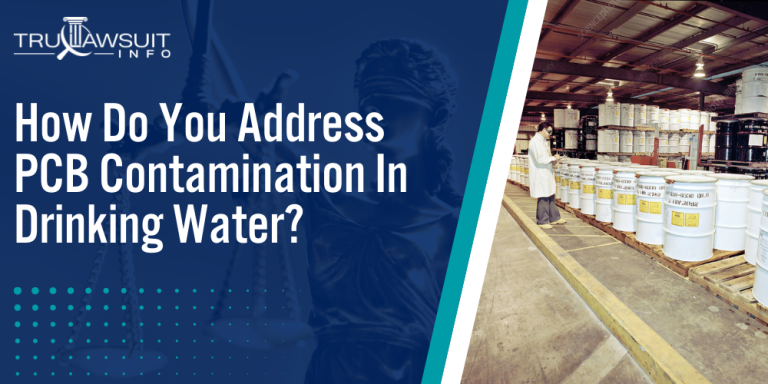
Intro to PCB Drinking Water Contamination
The most common source of PCB exposure for the general public is through the consumption of contaminated food.
PCB contamination can occur in several ways including, but not limited to:
- Ingestion;
- Inhalation; and
- Skin contact
If you or a loved one has experienced adverse health conditions after being exposed to PCB chemicals, you may be eligible to pursue compensation.
Contact TruLawsuit Info today using the chat on this page to receive an instant case evaluation.
Adverse Health Effects of PCB Contamination
Polychlorinated biphenyls (PCBs) are toxic substances that pose significant health risks.
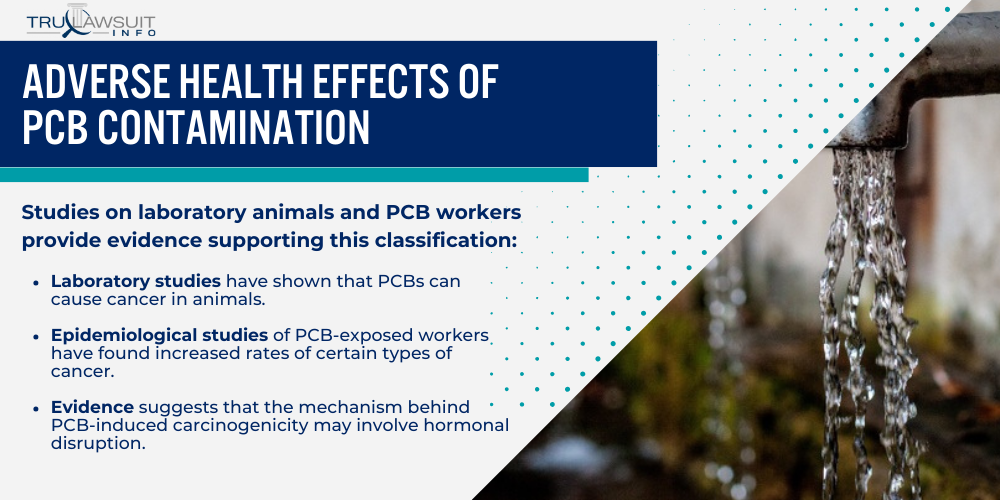
The exposure to PCBs, particularly through drinking contaminated water or eating contaminated fish, can lead to a range of adverse health effects affecting the immune and reproductive systems, and may even have carcinogenic implications for human health.
Probable Human Carcinogens
Polychlorinated biphenyls (PCBs) are classified as probable human carcinogens by several health agencies.
Studies on laboratory animals and PCB workers provide evidence supporting this classification:
- Laboratory studies have shown that PCBs can cause cancer in animals.
- Epidemiological studies of PCB-exposed workers have found increased rates of certain types of cancer.
- Evidence suggests that the mechanism behind PCB-induced carcinogenicity may involve hormonal disruption.
- Long-term exposure to PCBs is most concerning, as it is more likely to result in health issues.
Adverse Effects on Immune and Reproductive Systems
Exposure to PCBs has been consistently associated with negative outcomes for both immune and reproductive health.
These compounds, once prevalent in electrical equipment and other industrial products, continue to pose a risk even after their production was banned.
PCBs have been linked to significant adverse health effects on both the immune and reproductive systems:
- PCB exposure can weaken the immune system, making the body more susceptible to diseases.
- Reproductive issues, such as reduced fertility and changes in sex hormones, have been observed in individuals with high PCB exposure.
- Developmental problems in children, potentially stemming from prenatal exposure to PCBs, have also been documented.
- Laboratory studies have reinforced these findings, showing similar effects in animals.
Implications for Special Populations
The dangers of PCB exposure are particularly pronounced in specific groups, underlining the importance of targeted health advisories and interventions.
Pregnant women and infants are especially sensitive to these contaminants, necessitating increased vigilance and protective measures.
Certain populations may be more vulnerable to the detrimental effects of PCB contamination in drinking water:
- Pregnant women may transfer PCBs to developing fetuses, increasing the risk of developmental disorders.
- Breastfeeding infants might receive PCBs through their mother’s milk, which could impact their growth and immune functions.
- Populations that rely on fish as a primary food source are at risk if those fish are contaminated with PCBs.
- PCB workers or those living in areas with high industrial pollution may face more direct exposure scenarios.
Sources of PCBs in the Environment
Polychlorinated biphenyls (PCBs) are pervasive environmental pollutants originating from a variety of sources that contribute to their presence in ecosystems and drinking water.
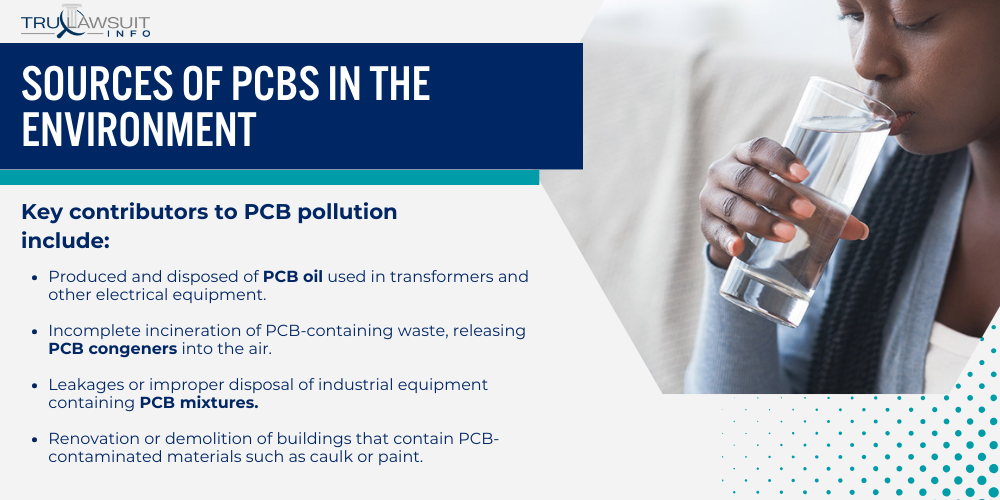
Pollution Through Industrial Processes
Industrial activities have historically been prime sources of PCB contamination in the environment.
PCBs were widely used in commercial PCB mixtures, such as coolant fluids in electrical apparatus, cutting fluids for machining operations, carbonless copy paper, and in heat transfer fluids.
Despite the discontinuation of PCB production due to health concerns, their legacy persists in the environment.
Key contributors to PCB pollution include:
- Produced and disposed of PCB oil used in transformers and other electrical equipment.
- Incomplete incineration of PCB-containing waste, releasing PCB congeners into the air.
- Leakages or improper disposal of industrial equipment containing PCB mixtures.
- Renovation or demolition of buildings that contain PCB-contaminated materials such as caulk or paint.
Contaminated Food Chain
The food chain is a significant pathway through which PCBs enter organisms, leading to a widespread issue of contaminated food and contaminated fish.
PCBs are resilient and are known to accumulate in the fatty tissue of living organisms.
Factors that exacerbate food chain contamination:
- Predatory fish may accumulate high levels of PCBs by consuming smaller, also contaminated, fish.
- Land animals may ingest PCBs through PCB-contaminated plant material or smaller prey.
- PCB mixtures can infiltrate agricultural systems via contaminated water used for irrigation or sewage sludge used as fertilizer.
- Humans are exposed to PCBs through the consumption of PCB-contaminated fish and meat or dairy products from animals that have ingested PCBs.
Accumulation in Wildlife and Aquatic Ecosystems
The ability of PCBs to resist degradation and dissolve in fats allows them to accumulate readily in wildlife, particularly aquatic environments.
This bioaccumulation poses serious risks to environmental health including the health of human populations.
Examples of PCB accumulation impacts:
- Marine mammals with high-fat reserves, such as seals, can harbor substantial amounts of PCBs.
- PCBs have been detected in breast milk, highlighting the potential for maternal transfer to offspring.
- Continuing sediment contamination affects bottom-dwelling species and those that feed on them.
- Environmental Protection Agency (EPA) guidelines recognize the threat of PCBs to endangered species, calling for ongoing monitoring and remediation efforts.
Legislation and Guidelines for PCBs
Regulatory frameworks at national and international levels are essential for addressing PCB contamination in drinking water.
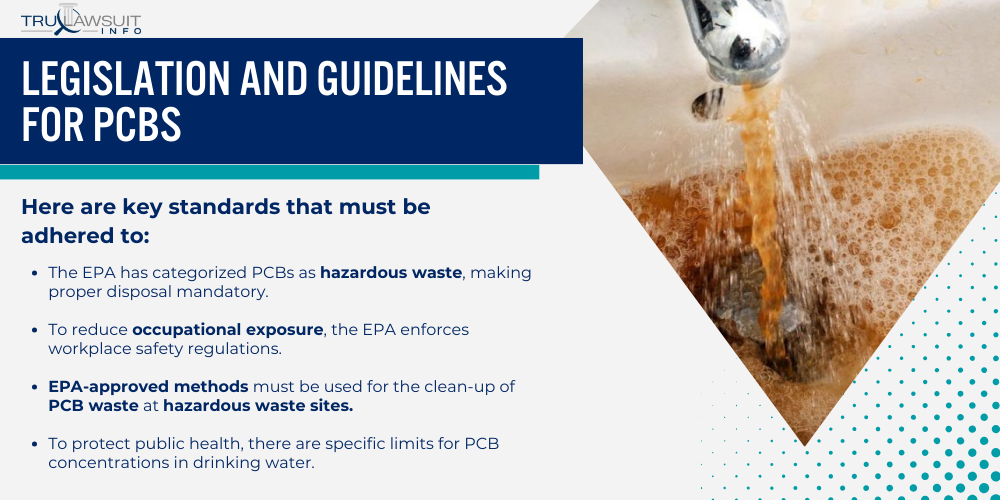
These regulations are designed to manage the risks and minimize human exposure to these harmful substances.
EPA Regulations and Safety Standards
The Environmental Protection Agency (EPA) enforces strict guidelines for managing and disposing of PCBs due to their classification as persistent organic pollutants.
Here are key standards that must be adhered to:
- The EPA has categorized PCBs as hazardous waste, making proper disposal mandatory.
- To reduce occupational exposure, the EPA enforces workplace safety regulations.
- EPA-approved methods must be used for the clean-up of PCB waste at hazardous waste sites.
- To protect public health, there are specific limits for PCB concentrations in drinking water.
EPA guidelines emphasize the reduction of PCB release into the environment and encompass requirements for handling and disposing of PCB-containing equipment.
International Agency Designations
The role of the International Agency in combating PCB pollution extends to classifying the threat they pose.
Important points regarding these designations include:
- The agency has classified PCBs as carcinogenic to humans based on epidemiological studies.
- PCBs are listed under the Stockholm Convention as persistent organic pollutants.
- Global agreements dictate the phase-out of PCBs and commit to reducing their release into the environment.
- Coordination between nations emphasizes sharing best practices and updates on handling PCB contamination.
These international guidelines assist countries in aligning their policies with a broader goal of minimizing PCB-related health risks to the population.
Preventing and Managing PCB Contamination
Addressing PCB contamination in drinking water entails strategic remediation, the enforcement of safe disposal practices, and regular monitoring to ensure public health and ecosystem protection.
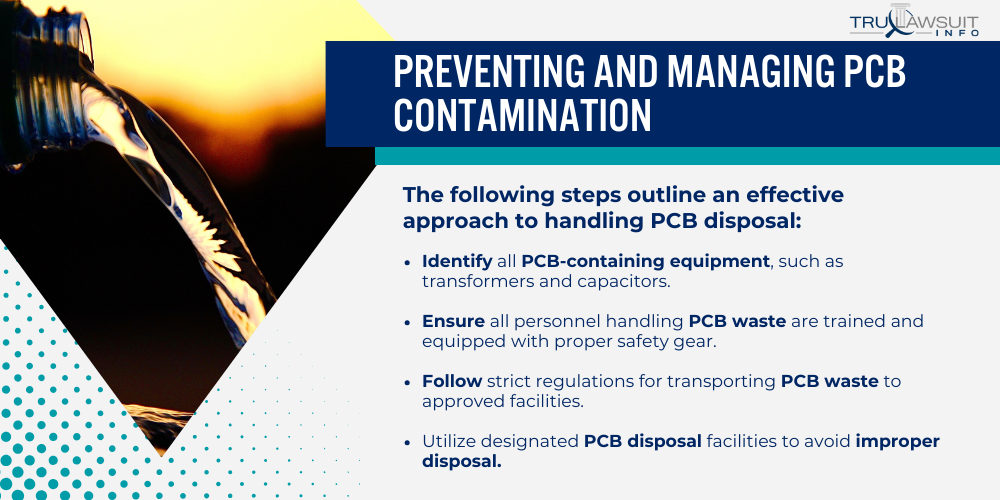
Safe Disposal of PCB-Containing Materials
Proper disposal of materials containing PCBs is crucial in preventing PCB exposures.
The following steps outline an effective approach to handling PCB disposal:
- Identify all PCB-containing equipment, such as transformers and capacitors.
- Ensure all personnel handling PCB waste are trained and equipped with proper safety gear.
- Follow strict regulations for transporting PCB waste to approved facilities.
- Utilize designated PCB disposal facilities to avoid improper disposal.
Remediation of Contaminated Sites
When tackling contaminated sites, dedicated efforts are needed to restore safety.
Implementing these measures can significantly reduce PCB levels in the environment:
- Isolate and remove contaminated soil and sediment to prevent further spread.
- Employ techniques such as dredging, capping, or soil washing for contaminated sediment.
- Perform risk assessments to inform and prioritize remediation actions.
- Restore contaminated sites using environmentally sensitive methods that support local ecosystems.
Monitoring PCB Levels in Populations and Environments
To safeguard against elevated PCB levels, ongoing monitoring is essential among populations and in environments likely to be affected by PCBs.
A robust monitoring program might include:
- Regular assessment of serum PCB levels in PCB workers and residents in at-risk areas.
- Environmental testing for PCBs entering the water, soil, and wildlife food chains.
- Long-term studies to observe how PCBs accumulate in different ecosystems.
- Prompt reporting and mitigation procedures when PCB levels surpass safety thresholds.
Minimizing Personal Exposure to PCBs
In combating PCB contamination in drinking water, it’s crucial to address personal exposure through various strategies, including making informed dietary choices and expanding public awareness through education.
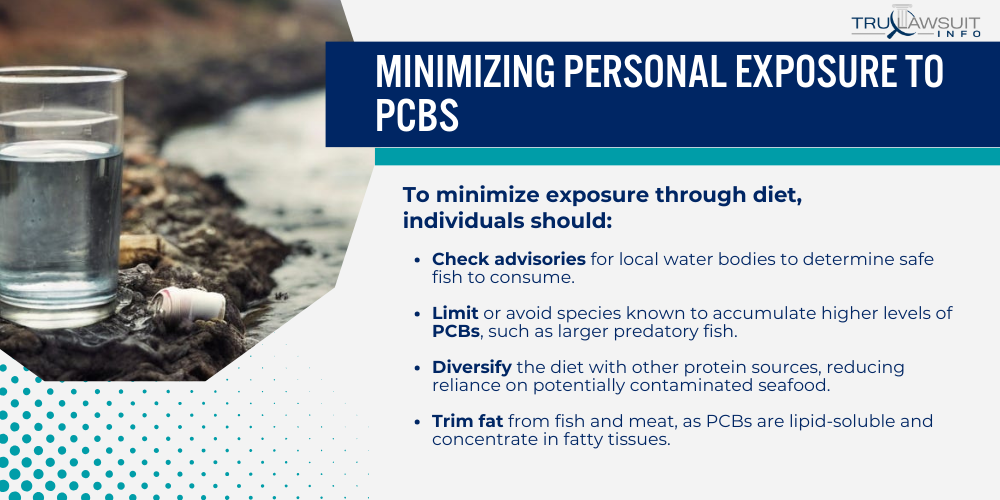
Advice on Dietary Choices
One’s dietary intake can be a significant route of exposure to PCBs, especially when consuming fish from contaminated waters.
Eating contaminated fish is a primary concern, thus being selective about seafood sources is vital.
To minimize exposure through diet, individuals should:
- Check advisories for local water bodies to determine safe fish to consume.
- Limit or avoid species known to accumulate higher levels of PCBs, such as larger predatory fish.
- Diversify the diet with other protein sources, reducing reliance on potentially contaminated seafood.
- Trim fat from fish and meat, as PCBs are lipid-soluble and concentrate in fatty tissues.
Educational Initiatives and Awareness
Education plays a crucial role in reducing personal PCB exposure.
Individuals who work with PCB capacitors, transformers, or hydraulic fluids in older electrical equipment are at elevated risk and must be well-informed.
For effective education and awareness:
- Implement training programs for PCB workers on safe handling and disposal practices.
- Promote understanding of PCB toxicity and the associated health risks, including birth defects and other conditions.
- Disseminate information on alternative products and methods that reduce the need for PCB-containing materials.
- Encourage community participation in local environmental decisions that impact PCB pollution reduction efforts.
Research and Insights on PCBs
Polychlorinated biphenyls (PCBs) are chlorinated hydrocarbons that have been widely investigated due to their environmental impact and persistence.
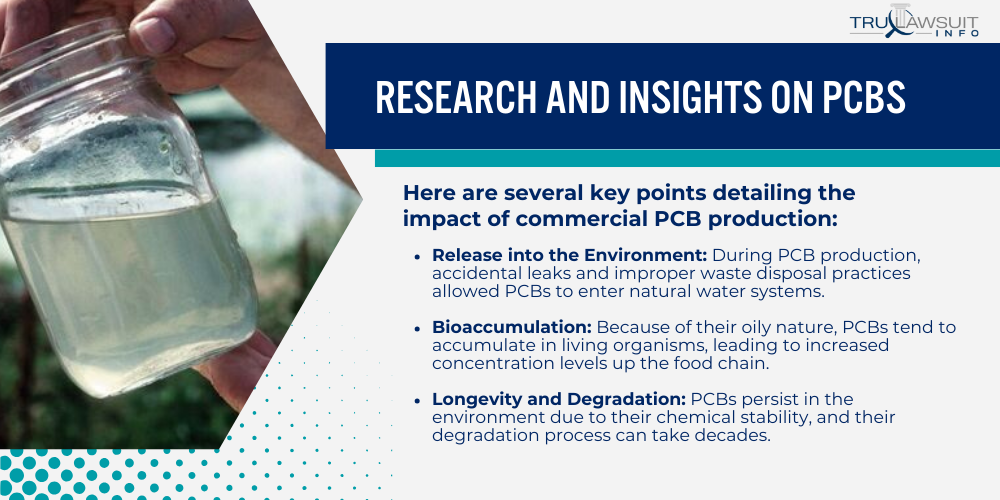
Once extensively used in commercial production for applications such as electrical transformers, these oily liquids are now intensely scrutinized.
Impact of Commercial PCB Production
The manufacturing process of PCBs historically contributed to widespread environmental contamination.
PCBs were produced on a large scale for their chemical stability and insulating properties in a variety of industrial applications, including use in electrical transformers.
Here are several key points detailing the impact of commercial PCB production:
- Release into the Environment: During PCB production, accidental leaks and improper waste disposal practices allowed PCBs to enter natural water systems.
- Bioaccumulation: Because of their oily nature, PCBs tend to accumulate in living organisms, leading to increased concentration levels up the food chain.
- Longevity and Degradation: PCBs persist in the environment due to their chemical stability, and their degradation process can take decades.
- Regulation and Bans: Recognizing their hazardous nature, many countries have now heavily regulated or banned PCBs, curbing their production and mitigating future release into ecosystems.
Case Studies on Occupational and Environmental Exposure
Occupational and environmental exposure to PCBs poses significant health hazards, confirmed by various medical tests and animal studies.
Workers in industries where PCBs were used or manufactured are known as PCB-exposed workers and have been routinely monitored.
Insights from case studies on exposure to PCBs reveal the following:
- Health Ramifications: Consistent exposure has been linked to various health issues, including skin conditions such as chloracne and potential disruptions to the immune and reproductive systems.
- PCB Congener Specificity: The type of PCB congener determines the degree of toxicity, with some congeners linked to more severe health outcomes.
- Occupational Safety Measures: Protective measures and safety regulations have since been improved to guard against workplace exposure risks.
- Monitoring of Workers: Regular medical surveillance of PCB-exposed workers has become a standard protocol in industries that historically used PCBs.
PCB Identification and Measurement Techniques
To safeguard public health, it is crucial to detect and measure polychlorinated biphenyls (PCBs) accurately in environmental samples.
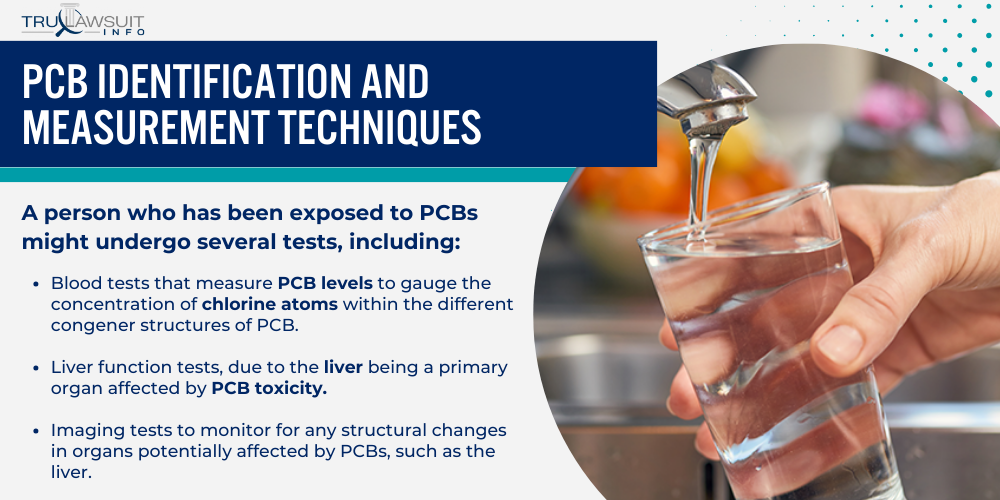
Since PCBs have been linked to serious health issues, such as liver cancer, reliable diagnostic and environmental monitoring techniques are essential for both medical testing and environmental monitoring.
Medical Testing for PCB Exposure
Medical tests are developed to assess PCB exposure in human populations, including individuals who might have worked in environments with PCB-containing materials, such as fluorescent lighting fixtures.
These tests must be both sensitive and specific to determine exposure levels.
A person who has been exposed to PCBs might undergo several tests, including:
- Blood tests that measure PCB levels to gauge the concentration of chlorine atoms within the different congener structures of PCB.
- Liver function tests, due to the liver being a primary organ affected by PCB toxicity.
- Imaging tests to monitor for any structural changes in organs potentially affected by PCBs, such as the liver.
- Focused medical evaluations for signs that could be correlated with past PCB exposure in electrical workers handling fluorescent light ballasts.
Environmental Monitoring of PCBs
Environmental monitoring targets areas suspected of PCB contamination, such as regions near factories that produce or use PCB-containing equipment.
Consistent surveillance protects human populations and wildlife from the dangers of PCBs.
Essential approaches for environmental monitoring of PCBs include:
- Sampling of water bodies and soil for PCB presence, especially around sites with known usage of PCBs in products.
- Long-term biomonitoring for assessing the trends of PCB levels over time.
- Advanced analytical methods, such as gas chromatography-mass selective detection (GC-MS), are utilized to accurately identify PCB congeners.
- The deployment of immunoassay techniques for faster screening of PCBs in the environment can be particularly useful in areas with a history of containing fluorescent lighting fixtures and ballasts.
Comparative Analysis of PCB Contamination
This section offers a detailed look at PCB contamination, its comparison to other persistent pollutants in water, and the specific risks associated with prenatal exposure to PCBs.
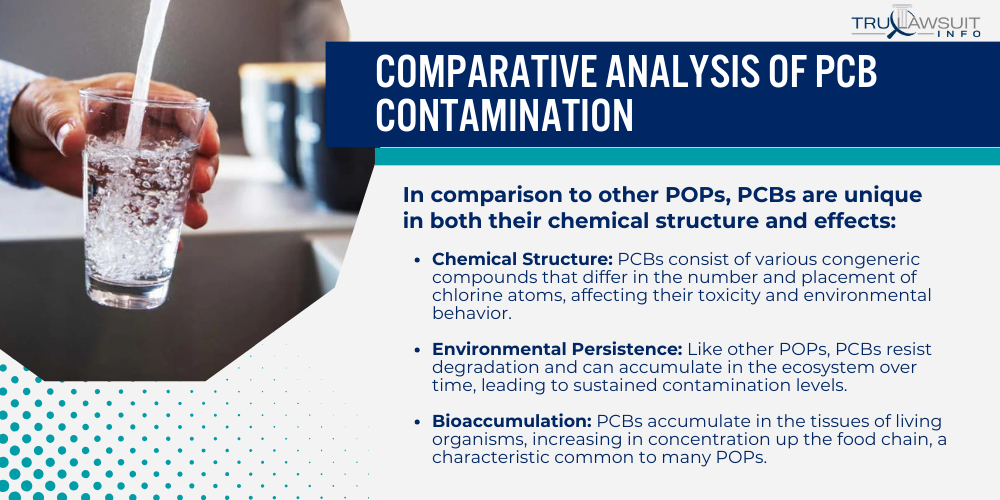
PCBs vs. Other Persistent Organic Pollutants
PCBs (polychlorinated biphenyls) are part of a broader category known as persistent organic pollutants (POPs), which are toxic compounds that remain in the environment for extended periods.
In comparison to other POPs, PCBs are unique in both their chemical structure and effects:
- Chemical Structure: PCBs consist of various congeneric compounds that differ in the number and placement of chlorine atoms, affecting their toxicity and environmental behavior.
- Environmental Persistence: Like other POPs, PCBs resist degradation and can accumulate in the ecosystem over time, leading to sustained contamination levels.
- Bioaccumulation: PCBs accumulate in the tissues of living organisms, increasing in concentration up the food chain, a characteristic common to many POPs.
- Health Risks: Health risks, such as liver damage and other biological effects, are shared by different POPs but vary based on the specific type and exposure levels to these toxic compounds.
Comparative analysis of PCBs, among other POPs, reflects their significance within the group, particularly in terms of ecological and human health implications.
Prenatal Exposure to PCBs and Other Chemicals
The issue of prenatal exposure to PCBs is particularly concerning due to potential developmental impacts.
When compared to prenatal exposure to other chemicals, the effects of PCBs can be distinct:
- Toxicity Levels: Even low levels of PCB toxicity may influence the development of the fetus, leading to potential long-term effects.
- Risk of Exposure: Pregnant individuals can be exposed to PCBs through contaminated food or water, and the risk varies depending on the environment and dietary habits.
- Developmental Outcomes: Studies have indicated that prenatal exposure to PCBs can affect neurological development and may have a role in endocrine disruption.
- Legislation and Regulation: Unlike some newer industrial chemicals, PCBs have been subject to international regulation due to their known toxicity, which continues to influence policies related to prenatal exposure.
Frequently Asked Questions
-
PCBs, or polychlorinated biphenyls, are chemical compounds with documented health risks.
Exposure to contaminated water can lead to immune system, reproductive, endocrine, and nervous system impacts, and they are classified as probable human carcinogens.
-
Several treatments effectively remove PCBs from drinking water.
These methods target and reduce PCB levels, ensuring safer water for consumption.
-
Regulatory agencies such as the Environmental Protection Agency (EPA) have established guidelines for PCB levels in water, setting the maximum contaminant level at zero, given the potential health risks.
Laws such as the Clean Water Act aim to maintain these standards.
-
Individuals concerned about PCBs in their water can use laboratory analyses to identify and quantify PCBs.
Employing certified professionals is recommended for accurate testing results.
-
The disposal of PCB-containing materials must be handled with care.
Recommended procedures include incineration at high temperatures or placement in approved chemical waste landfills to prevent environmental contamination.
-
Environmental agencies employ monitoring programs to regularly test water sources for PCBs.
They also work on preventing illegal discharge and ensuring proper disposal of PCB-containing materials, which helps to minimize PCB levels in water sources.

Attorney Jessie Paluch, founder of TruLawsuit Info, has over 25 years of experience as a personal injury and mass tort attorney, and previously worked as an international tax attorney at Deloitte. Jessie collaborates with attorneys nationwide — enabling her to share reliable, up-to-date legal information with our readers.
Legally Reviewed
This article has been written and reviewed for legal accuracy and clarity by the team of writers and legal experts at TruLawsuit Info and is as accurate as possible. This content should not be taken as legal advice from an attorney. If you would like to learn more about our owner and experienced injury lawyer, Jessie Paluch, you can do so here.
Fact-Checked
TruLawsuit Info does everything possible to make sure the information in this article is up to date and accurate. If you need specific legal advice about your case, contact our team by using the chat on the bottom of this page. This article should not be taken as advice from an attorney.
You can learn more about the PCB Exposure Lawsuit by visiting any of our pages listed below:
Here, at Tru Lawsuit Info, we’re committed to helping victims get the justice they deserve.
To do this, we actively work to connect them with attorneys who are experts in litigating cases similar to theirs.
Table of Contents
Tru Lawsuit Info is a reliable source of information about issues that may affect your health and safety, such as faulty products, data breaches, and environmental hazards.
Our team of experienced writers collaborates with medical professionals, lawyers, and advocates to produce informative articles, guides, and other resources that raise awareness of these topics.
Our thorough research provides consumers with access to reliable information and updates on lawsuits happening around the country. We also can connect consumers with attorneys if they need assistance.
Here, at Tru Lawsuit Info, we’re committed to helping victims get the justice they deserve.
To do this, we actively work to connect them with attorneys who are experts in litigating cases similar to theirs.
